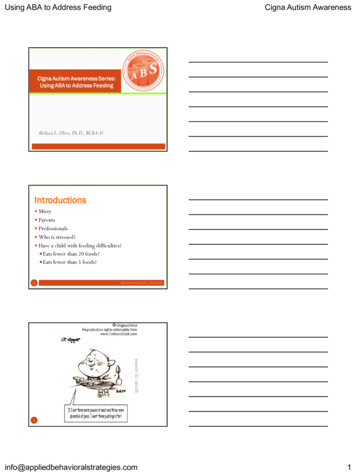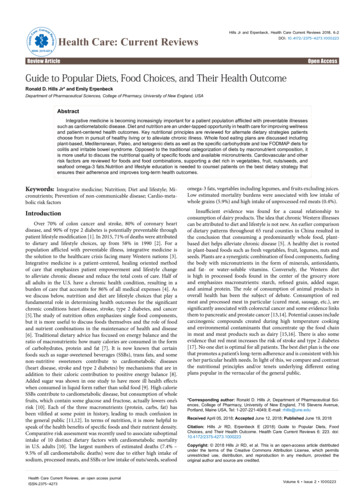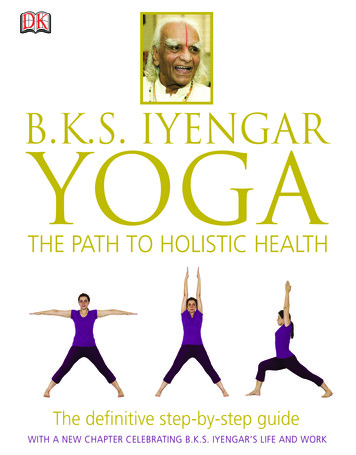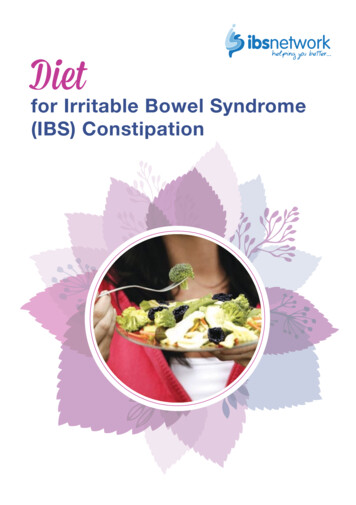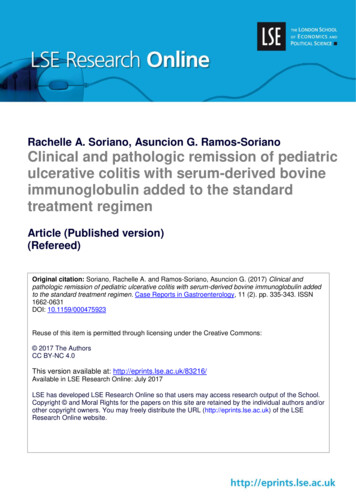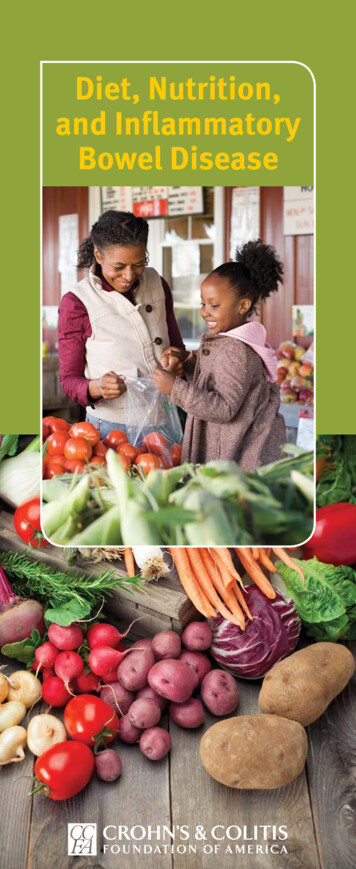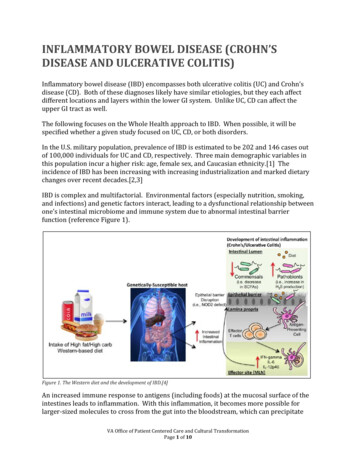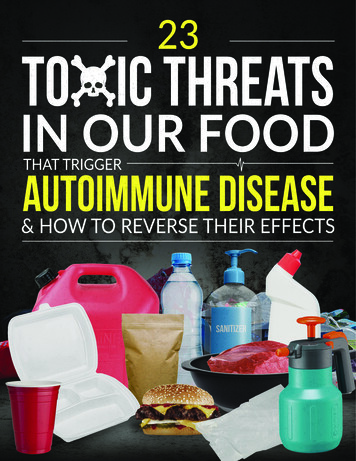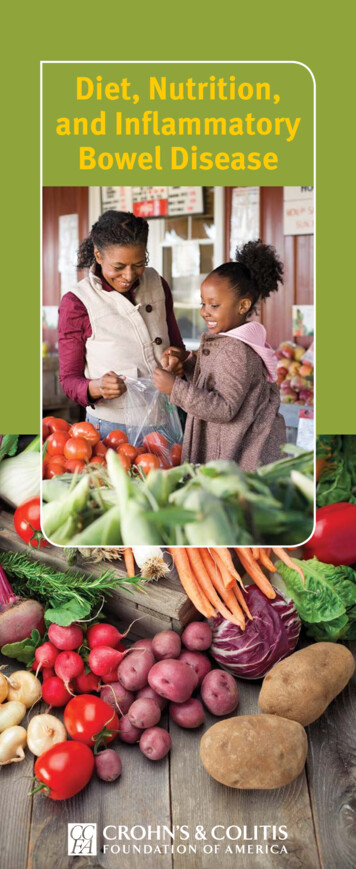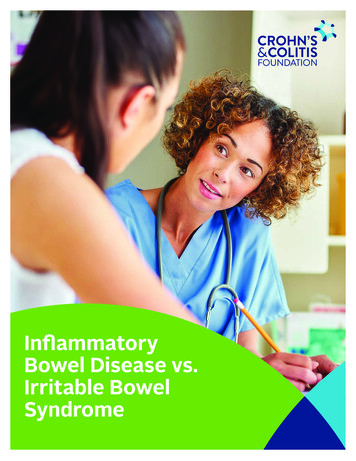
Transcription
InflammatoryBowel Disease vs.Irritable BowelSyndrome
What is the Difference BetweenInflammatory Bowel Disease (IBD)and Irritable Bowel Syndrome (IBS)?IBD and IBS are two illnesses that can affect the gastrointestinal (GI) tract. Both can cause abdominal pain andchanges in bowel movements; however, they are notthe same. While there are many similarities between IBDand IBS, it is important to highlight the differences.IBD: Chronic inflammatory diseasesinvolving the GI tract, includingCrohn’s disease and ulcerativecolitis. Immune cells cause inflammationand ulceration in the lining ofthe intestines, which can lead tofrequent and/or urgent bowelmovements, abdominal pain,diarrhea, or bleeding.IBS: Functional GI disorder thatcauses recurrent abdominal painand changes in bowel movements.VS. Symptoms may include bloating,constipation, diarrhea, or mixeddiarrhea with constipation. Patients with IBS have thesesymptoms without damageto the GI tract. In IBD, the GI tract is damaged.Symptoms can be different foreveryone and depend on the typeof IBD and where the inflammationis located in the GI tract. Endoscopy and radiology testsdo not show inflammation.1
Inflammatory BowelDiseaseIBD is a term for chronic inflammation of thegastrointestinal tract. The two most commoninflammatory bowel diseases are Crohn’s diseaseand ulcerative colitis (UC). IBD affects as manyas 3.1 million Americans,1,2 most of whom arediagnosed before age 35. There are currently nocures for IBD, but there are treatments to reducebowel inflammation and control the symptomsof the disease.They may also have times of remission, whenlittle or no symptoms are present. When bowelinflammation is reduced by taking an effectivemedication treatment, flares are less frequent.StricturePatchy inflammationContinuous andthroughout smalluniform inflammationand large bowelin the large bowelCrohn’s DiseaseUlcerative ColitisAge of onset: 15–35 years and 55–70 yearsAge of onset: 15–35 years and 55–70 yearsSymptoms: Depends on location of disease.Symptoms: May include stool urgency, fatigue,May include abdominal pain, diarrhea,weight loss and fatigue.increased bowel movements, mucous in stool,nocturnal bowel movements and abdominal pain.Bloody stool: VariableBloody stool: CommonMalnutrition: CommonMalnutrition: Less commonCausesThe exact cause of IBD remains unknown.Researchers believe that a combination of factorsinteract, leading a patient to develop IBD. Inherited genetic risk Environmental risk factorsCrohn’s disease and UC cause chronic inflammationof the GI tract. Crohn’s disease can affect any partof the GI tract, but frequently affects the end ofthe small intestine and the beginning of the largeintestine (colon). The inflammation in Crohn’sdisease can involve the entire bowel wall. UC affectsonly the large intestine (colon) and the rectum. Theinflammation in UC involves only the inner lining ofthe intestine. Imbalance or changes in the intestinal bacteria(gut microbiome)SymptomsWho Gets IBD? An inappropriate reaction from the immune systemNormally, immune cells protect the body frominfection, but in people with IBD, the immune systemmistakes harmless substances in the intestine forforeign substances and launches an attack, causinginflammation.The symptoms of IBD vary from person-to-person,may depend on what part of the bowel is affectedby inflammation, and may change over time.Common symptoms for Crohn’s disease and UCinclude frequent and/or urgent bowel movements,diarrhea, bloody stool, abdominal pain, and cramping.As many as 70,000 new cases of IBD are diagnosedin the United States each year. Age: IBD can occur at any age, but the median ageof diagnosis is 29.5 years for Crohn’s disease and34.9 years for ulcerative colitis.3 Gender: In general, IBD affects men andwomen equally.People with IBD may also report symptoms suchas fatigue, lack of appetite, and weight loss. Peoplewith IBD may have times of active disease (flare),when symptoms and bowel inflammation are present.2
Ethnicity: IBD is more common amongCaucasians, but it can affect people of anyracial or ethnic group.The exact cause of Crohn’sdisease and UC remains unknown.Researchers believe that severalfactors, such as genetic risk andan inappropriate reaction fromthe immune system, play a rolein their development. Family history: The risk for developing IBDis between 1.5 percent and 28 percent forfirst-degree relatives of an affected person.4 Cigarette smoking: Smokers are more likely todevelop Crohn’s disease. UC is more common innon-smokers and former smokers.Diagnostic ProceduresTo help confirm a diagnosis of Crohn’s disease or UC,one or more of the following tests and diagnosticprocedures may be performed: Endoscopic procedures: Endoscopies get adetailed look at the inside of your digestive tractusing a small camera mounted to the end of alighted tube. Blood tests: The presence of inflammation in thebody can be identified by examining the levels ofseveral factors in the blood, including red and whiteblood cells, platelets, and C-reactive protein (CRP)— a protein made by your liver that is sent into yourbloodstream in response to inflammation.Crohn’s disease:An upper endoscopy lets doctors see the GI tractfrom the top down, using a flexible, lighted tubethat’s inserted through your mouth, down theesophagus, into your stomach, and as far down asthe duodenum, which is the first section of yoursmall intestine.Tests may be performed to help healthcare providers differentiate IBD from non-IBD. Blood testscan be used to evaluate a patient’s risk of developing disease complications, or to check if and howmedications are working in the body.Ulcerative colitis:A sigmoidoscopy allows your doctor to examinethe extent of the inflammation in your lower colonand rectum. Stool tests: Stool tests may check for infectionor inflammation (fecal calprotectin) in the GI tractby examining levels of a protein in the stool calledfecal calprotectin.Crohn’s disease and ulcerative colitis:A colonoscopy allows doctors to examine thecolon, the lowest part of your large intestine,by inserting a flexible, lighted tube through theopening to your anus. External imaging procedures: Images of thedigestive organs and other soft tissues aretaken from outside the body. Examples includecomputerized tomography (CT) scans andmagnetic resonance imaging (MRI).IBD ComplicationsPossible complications of IBD can include: Bowel obstruction Deep ulcerations Extraintestinal manifestations Infection Malnutrition Precancerous changes in the colonor colon cancer3
Irritable Bowel SyndromeIBS is a condition that affects the function andbehavior of the intestines. Normally, the muscleslining the intestines contract and relax to movefood along the digestive tract. In IBS, this patternis disturbed, resulting in uncomfortable symptoms.In addition, there can be a disturbance in sensation,with heightened sensitivity to normal gas or stoolpassing through the GI tract. It is important toremember that patients with IBD can also have IBS,but having IBS does not lead to IBD.SymptomsMany people experience mild symptoms of IBS, butfor some, symptoms can be severe. Symptoms caninclude cramping, abdominal pain, bloating, gas,mucus in the stool, diarrhea, and/or constipation.Much like IBD, there may be times when symptomsare present and times when little or no symptomsare present. But, unlike IBD, IBS does not causeinflammation, does not cause permanent damageto the GI tract, and does not increase the risk ofcolorectal cancer. Family history: Research shows that many peoplewith IBS have a first-degree relative (parent, child,or sibling) with the disorder. Infection: Around 40% of people who develop IBSdo so after an infection in their digestive system.After the infection clears, the symptoms remain(i.e., post-infectious IBS). Psychological history: Some studies indicate thatpsychological distress, especially anxiety, depression, and childhood trauma, may be risk factors.CausesDiagnostic ProceduresThe exact cause of IBS is unknown. Potential causesmay include sensitivity of the GI tract to gas andbloating, changes in the microbiome (organismsin the gut), or changes in the levels of specificcompounds or chemicals within the body, such asserotonin—a chemical in the body that helpsregulate mood and social behavior. Although stressdoes not cause IBS, many people with IBS noticethat stress does aggravate their symptoms. HavingIBD or a recent GI tract infection (like gastroenteritis)can increase the risk for developing IBS.Diagnosing IBS typically involves a physical examand medical history. It is important to exclude otherGI conditions. The Rome IV criteria defines IBSas recurrent abdominal pain, on average one daya week in the last three months, associated withat least two of the following:61) Relation to defecation (discharging feces)2) Change in frequency of stoolWho Gets IBS?3) Change in the form (appearance) of the stool.IBS affects 10–12% of adults in North America.5The evaluation may include blood tests, stool samples,endoscopic procedures, or imaging procedures(like a CT scan or MRI). In patients with IBS, anemiais not apparent, stool calprotectin is normal, and noinflammation is seen on endoscopy or imaging tests. Age: IBS occurs in all age groups, but is mostcommonly diagnosed in individuals under age 50.5 Gender: IBS is more common in women.ComplicationsIBS does not cause inflammation,damage the GI tract, or increasethe risk of colorectal cancer.IBS can significantly affect quality of life. Researchshows that patients with IBS may undergomore medical testing, as compared with patientswithout IBS.4
IBSMay include diarrhea, abdominal pain,cramping, urgent or frequent bowelmovements, blood in the stool, decreasedappetite, weight loss, or joint pain.May include diarrhea, constipation, abdominal pain,abdominal bloating, cramping, mucus in stool, bloating,and/or gas. Anemia may be present No anemia is present Stool calprotectin is often elevated Stool calprotectin is normal Endoscopy: redness, ulceration, bleedingseen with scope Endoscopy: No inflammation is seen with a scopeTreatments are prescribed to reduce bowelinflammation and control symptoms:Aminosalicylates, antibiotics, biologicor biosimilar therapies, corticosteroids,immunomodulators, or JAK inhibitors maybe recommended.For more information on IBD medicationsvisit www.ibdmedicationguide.org. Imaging (CT or MRI): No inflammation of thebowel wallTreatments are prescribed to treat specific IBS symptoms:DiarrheaMedications: Alosetron, atropine, eluxadoline, loperamide,diphenoxylate, rifaximinOther: low FODMAP diet, gluten-free diet, behavioralinterventions (cognitive behavioral therapy, gut-directedhypnotherapy)ConstipationMedications: Linaclotide, lubriprosone, plecanatideOther: General laxatives, fiber supplementation withpsyllium, behavioral interventions (Cognitive BehavioralTherapy, Gut-Directed Hypnotherapy)Treatment Imaging (CT or MRI): inflammationof bowel wall is commonBlood in the stool and weight loss are NOT typically seenin IBS, and joint pain is uncommon.DiagnosticsIBDSymptomsSimilarities and Differences Between IBD and IBSPain: Antispasmodics (hyoscyamine, dicyclomine,peppermint oil), tricyclic antidepressants, selectiveserotonin reuptake inhibitors, psychological therapies(cognitive behavioral therapy, gut-directed hypnotherapy,relaxation therapy).Crohn’s disease—Stenosis, fistula, abscess,bowel obstruction, and colon cancer (if thecolon is involved)UC—Colon cancer and toxic megacolonChronic constipation and diarrhea may causehemorrhoids.Psychological Impacts: Impaired quality of life, increasedrisk for anxiety and depression, and stigmatization.Both Crohn’s disease and UC—ulcers,malnutrition, anemiaPsychological Impacts: Impaired quality oflife, increased risk for anxiety, depression, andpost-traumatic stress, and stigmatization.5ComplicationsBloating/Gas: Probiotics, dietary changes
Treating IBD and IBS Reduce the amount of greasy or fried foods:High-fat foods may cause diarrhea and gas dueto poor fat absorptionDiet and Nutrition Watch dairy intake: Persons who are lactoseintolerant or who are experiencing IBD or IBS mayneed to limit the amount of milk or milk productsthey consumeIBD and IBS are not caused by diet. However, manypatients notice that diet can affect symptoms. There is no single diet or eating plan that works foreveryone, so work with your healthcare team and/or dietitian to create a plan that works for you Keep a food diary and eliminate (trigger) foods:Eliminate any foods that make symptoms worse.These may include gassy food (such as beans,cabbage and broccoli), spicy food, popcorn, andalcohol, as well as foods and drinks that containcaffeine, such as chocolate and soda Keep a food journal to track your symptoms wheneating different food groups Slowly introduce new foods into your diet Dietary recommendations must be individualizedIt is important to keep a food journal to help youunderstand which foods can be tolerated, and whichfoods increase symptoms during a flare.The key is to strive for a well-balanced, healthy diet.A balanced diet should include an adequate amountof calories and nutrients, as well as contain foodsfrom all food groups.To learn more about diet and nutrition, view ourDiet, Nutrition, and Inflammatory Bowel Diseasebrochure by visiting: www.crohnscolitisfoundation.org/brochures.It is also important for people with IBD or IBS to payattention to fluid intake. Chronic diarrhea can leadto dehydration. Stay hydrated by drinking enough tokeep your urine light yellow to clear.MedicationsFor a listing of medications used to treat IBD and/orIBS, please refer to the chart on page 5.During disease flare-ups, eating may cause abdominaldiscomfort and cramping. Here are some ways toreduce those symptoms:Anxiety and Depression Eat smaller meals at more frequent intervals:Eat five small meals a day, every three or fourhours, rather than the traditional three largemeals a dayFor patients with IBD and IBS, anxiety and depressioncan make symptoms worse. Consultation with apsychologist or psychiatrist familiar with IBD and IBScan be very helpful in managing these conditions.Treating the physical symptoms of IBD and IBS maybe more complicated when depression and anxietyare uncontrolled. There are pharmacological or psychological treatments for both of these conditions.Treatment of anxiety and depression can be animportant part of IBD and IBS, and may make caremore effective.Psychological TherapiesPatients treated with psychological therapies mayexperience improvement in their symptoms. Twoforms of psychotherapy—cognitive behavioraltherapy (CBT) and gut-directed hypnotherapy—have the most evidence for reducing pain as wellas the frequency, intensity, and duration of IBDand IBS symptoms.6
feel stressed and organize the list into problems thatyou have some control over (e.g., cleaning the house,finishing a project at work) and problems that youcannot control (e.g., having a diagnosis of IBD or IBS).By doing this, patients can make adjustments inhow they think about their stress, and change theirbehavior to be more adaptable to solvable versusunsolvable problems.A stress journal may help identify the regular stressors in life and the ways to deal with them. Over time,patterns and common themes will emerge, as wellas strategies to successfully cope with them. Beloware additional strategies to help manage stress: Talk to a trusted friend or make an appointmentwith a therapist: Expressing what you are goingthrough can be very helpful, even if there is nothingyou can do to change the stressful situation. Thiscan also include spending time with positive peoplewho enhance your life, and thus reduce stress. Astrong support system will buffer you from thenegative effects of stress. Nurture yourself: If you regularly make time forfun and relaxation, you will be in a better place tohandle life’s stressors when they inevitably come.Such activities can include hobbies, satisfyingsocial interactions, yoga, and meditation.CBT has shown promise for patients with moderateto severe IBD and for those with IBS who also sufferfrom anxiety or mood disorders.7 CBT can helppatients learn coping strategies to control thesymptoms brought on by anxiety. Engage in physical activity: Studies show thatphysical activity plays a key role in reducing andpreventing the effects of stress. Make time for atleast 30 minutes of exercise, five times per week.Gut-directed hypnotherapy is one of the mostsuccessful treatment approaches for chronic IBS,both in the short-term and the long-term with manypatients finding symptomatic relief.8 Studies suggestthat in addition to decreasing pain perception at thelevel of the brain, hypnosis may improve immunefunction in IBD and IBS, increase relaxation, reducestress, and ease feelings of anxiety. Eat a healthy diet: Well-nourished bodies arebetter prepared to cope with stress, so be mindfulof what you eat. Start your day with breakfast,and keep your energy up and your mind clear withbalanced, nutritious meals throughout the day.Reducing and Managing StressEven in the absence of a psychiatric diagnosis, manypeople with IBD and IBS report that stress makestheir symptoms worse. Relaxation techniques andmind/body exercises, such as yoga, tai chi, andmeditation may help, particularly when used withother forms of treatment. Get enough sleep: Adequate sleep fuels yourmind, as well as your body. Feeling tired willincrease your stress because it may cause you tothink irrationally. Utilizing various sleep techniques(e.g., waking up at the same time each morningor going to bed only when sleepy) can be veryeffective for insomnia.Other stress management options include relaxationtraining, such as meditation, guided imagery, orbiofeedback.If you have questions, call the Irwin M. and SuzanneR. Rosenthal IBD Resource Center (IBD Help Center)at 888-MY-GUT-PAIN (888-694-8872).To manage stress, it helps to identify sources of stress.One strategy is to write down what is causing you to7
Frequently Asked Questionsand x-ray studies. Fever, anemia, rectal bleeding, andunexplained weight loss are not symptoms of IBS,and may need to be evaluated by your physician.Is it possible to have both IBD and IBS?Yes, it is possible to be diagnosed with bothconditions. Some symptoms are unique to IBDor IBS, while some are shared.How long does the treatment taketo relieve symptoms of IBS?Relief of IBS symptoms is often a slow process. Itmay take months for definite improvement to beachieved. The tendency for the intestine to respondto stress will always be present. Managing yourstress, eating a proper diet, and use of appropriatemedications if possible, can greatly improve or insome cases, eliminate IBS.Can children get IBD or IBS?IBD is most commonly diagnosed between the agesof 15 and 35, although it is possible to have the disease at a younger or older age. It is estimated that10% – 15% of older children and adolescents sufferfrom IBS.9 In a subset of these youth, the symptomsare often linked to school- or social-related anxietyand can often resolve spontaneously or afterpsychological treatment.How can I find additional information?Patients with IBD can visit the Crohn’s & ColitisFoundation’s website at www.crohnscolitisfoundation.org for information and resources.Can IBS turn into Crohn’s diseaseor another more serious condition?Patients with IBS can visit the International Foundation for Functional Gastrointestinal Disorders’ websiteat www.aboutibs.org for information and resources.If IBD has been ruled out as a cause of symptomsin patients suspected of having IBS, there is noevidence that IBS progresses to any other diseaseor causes any complications outside of the regularsymptoms.CreditsReviewers:Sushila Dalal, MD, Ann Flynn, MD, Kian Keyashian, MD,and Tiffany Taft, PsyD, MIStiHow can I tell if the problem I have is IBSor something else?A careful medical history and physical examinationby a gastroenterologist or other physician areessential to rule out more serious disorders.Depending on your physician’s assessment, additionaltests may be considered and can include bloodtests, stool tests, visual inspection of the inside ofthe colon with flexible sigmoidoscopy or colonoscopy,Contributors:Kelsey Bladow and Gay KlapmanDesign and Layout:Rubicon Design AssociatesReferences1. Loftus EV, Jr., Shivashankar R, Tremaine WJ, HarmsenWS, Zinsmeiseter AR. Updated Incidence andPrevalence of Crohn’s Disease and Ulcerative Colitisin Olmsted County, Minnesota (1970-2011).6. Lacy BE, Patel NK. Rome Criteria and a DiagnosticApproach to Irritable Bowel Syndrome. J Clin Med.2017 Oct 26;6(11). pii: E99. doi: 10.3390/jcm61100997. )30406-2/pdf2. National Center for Health Statistics. Survey Description,National Health Interview Survey, 2015.Hyattsville,Maryland. 2016.8. Gholamrezaei A, Ardestani SK, Emami MH. Where doeshypnotherapy stand in the management of irritablebowel syndrome? A systematic review. J AlternComplement Med 2006; 12: 517–527.3. https://www.ncbi.nlm.nih.govpubmed/278563644. Santos MPC, Gomes C & Torres J (2018) Familialand ethnic risk in inflammatory bowel disease. Ann.Gastroenterol. (1):14-23.9. 41/5. Ford AC et al. Am J Gastroenterol (2018) -x8
This brochure is supported, in part, byDiaSorin S.p.A.Additional support is provided through theCrohn’s & Colitis Foundation’s annual givingprogram and donors.733 Third AvenueSuite 510New York, NY e Crohn’s & Colitis Foundation is the leading non-profitorganization focused on both research and patient support forinflammatory bowel disease (IBD). The Foundation’s mission isto cure Crohn’s disease and ulcerative colitis, and to improve thequality of life for the more than 3 million Americans living withIBD. Its work is dramatically accelerating the research processthrough our database and investment initiatives; it also providesextensive educational resources for patients and their families,medical professionals, and the public.10/2019
of the disease. Crohn's disease and UC cause chronic in ammation of the GI tract. Crohn's disease can a'ect any part of the GI tract, but frequently a'ects the end of the small intestine and the beginning of the large intestine (colon). The in ammation in Crohn's disease can involve the entire bowel wall. UC a'ects
